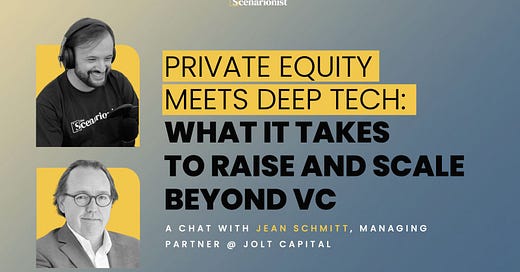✨ This is a Free Edition of The Scenarionist. To enjoy the full experience, become a Premium Member!
Welcome to the 67th edition of Deep Tech Catalyst, the channel by The Scenarionist, where science meets venture!
Venture capital typically backs the early stages—team building, refining the business model, finding product-market fit. Private equity enters later, when companies begin showing strong commercial traction and the need shifts from validation to acceleration. But for deep tech founders, approaching private equity isn't just about timing—it's about knowing what to show, how to scale, and why gross margin matters more than vision decks.
In this episode, we sit down with Jean Schmitt, Managing Partner at Jolt Capital. With decades of experience navigating the intersection of high-tech innovation and institutional capital, Jean breaks down what private equity really looks for, why deep tech founders often misprice their value, and how gross margins—not hype—win deals.
Together, we dig into:
How private equity funds actually work—and how they differ from VC.
The metrics and market signals that unlock late-stage capital.
What it takes to cross the elusive $100M revenue threshold—and why that changes everything.
Whether you’re a founder preparing for the next fundraising milestone or an investor exploring capital-efficient deep tech models, this episode offers a rare look inside the private equity mindset—and what it really takes to scale from strong tech to strong business.
Let’s dive in! 💡
✨ For more, see Membership | Partnership | Deep Tech Briefing | Insights
KEY INSIGHTS FROM THE EPISODE
🏦 How a Private Equity Fund Works
Private equity firms operate by designing financial products that must meet strict criteria, both in terms of return expectations and compliance with quality and ESG standards. These products are then offered to large institutional investors—pension funds, sovereign wealth funds, insurance companies, banks, and family offices. While these institutions manage enormous assets, only a very small percentage—typically 0.1% to 0.2%—is allocated to high-risk asset classes like venture capital. A slightly higher portion is allocated to less risky classes, including private equity.
When Private Equity Steps In
Venture capital typically focuses on early-stage challenges—building teams, refining business models, and solving initial market fit issues. Private equity, on the other hand, intervenes when companies start to achieve commercial traction.
As soon as customers begin to arrive—and growth accelerates—support is needed to establish scalable processes, formalize business development efforts, and prepare for the next leap.
One key focus is ambition. A company generating $15 million in revenue might wonder: Is this enough? Can it grow to $300 million? Or even beyond? In rare but real cases, companies have scaled from just a few million in revenue to over a billion within a relatively short timeframe. Understanding what is possible—and how to prepare for that level of growth—is a core part of the private equity value proposition.
Scaling Is a Strategic Mindset
Startups must be seen for what they truly are: companies. The principles of growth and scalability apply regardless of the label. Growing rapidly can also involve inorganic strategies, such as raising capital to acquire a larger competitor or leveraging a strategic customer relationship to scale quickly.
Fund Structures, Timelines, and Early Engagement Strategies
Private equity operates under a stricter discipline. A fund with a 10-year life must close all positions within that time frame. If the investment period is four years, then the final portfolio company must be fully exited within the remaining six. This structure creates a clear timeline and reduces holding periods, which in many cases average under five years. To achieve this, a structured approach is essential.
Companies are supported through detailed, month-by-month growth plans over a 36-month cycle. These plans are customized per company, but follow a proven framework designed to accelerate scaling within a defined period.
Engagement with companies often begins far before any capital is committed. When potential is identified—typically through strong technology and a solid go-to-market strategy—building a relationship early becomes a priority.
The objective is to be positioned as the trusted growth partner when the company reaches the critical revenue threshold, typically around €10 million.
What Makes a Deep Tech Company Interesting for a PE fund?
Certain criteria must be met before a company is considered for long-term collaboration. The business must be rooted in real, protected technology—ideally with strong patent coverage—and a commercially viable go-to-market approach.
What matters is grounded execution, a solid product, and the ability to build a business that makes sense both operationally and financially.
Early engagement works best when founders are pragmatic, focused, and dedicated to building. These are the businesses that private equity is designed to help scale.
🎯 2 Key Factors That Private Equity Investors Look for in Deep Tech Startups
1. Gross Margin as the Core Metric
When assessing opportunities in deep tech, it’s essential to move beyond simplistic comparisons like hardware versus software. The real question is value creation—and more specifically, gross margin. A business that can consistently deliver strong gross margins is far more likely to capture investor interest, regardless of whether it sells machines or licenses software.
“I don't look at hardware versus software. I look at gross margin. How much value can you create, and how much can you extract from a deal? If you can generate more than 45% gross margin, you're very, very interesting to me. It’s all about value creation. And say you’re selling a machine to the semiconductor industry for a million apiece, with 50% gross margin—you’re just as good as software.”
Especially when those machines are part of a production line—selling one unit often leads to selling many more. This repeat-buy logic, combined with large contract values and high customer stickiness, can outperform typical software-as-a-service economics.
In contrast, SaaS businesses with high customer acquisition costs or significant infrastructure expenses (like excessive server costs) may be far less attractive. The key is to demonstrate that customers are willing to pay a premium, not because of hype, but because the underlying technology creates a genuine, high-value impact.
Companies must prove they are not commodities. This means showing that the business deserves to exist, not just because it functions, but because it does so with superior profitability. Margins should be healthy, and pricing should reflect a meaningful competitive edge. Without that, even the most exciting technology becomes difficult to scale effectively.
2. A great business must be positioned within a clearly defined and growing market.
Ideally, the target should be a niche that is large enough to matter—perhaps $1 billion in size—but small and fragmented enough that leadership is attainable.
Being realistic is crucial. Claiming the intent to dominate a $500 billion global market may sound ambitious, but it’s rarely credible.
“If you're in a $1 billion niche growing at 25% a year, I love it. And especially if, within this billion, you have 50 players and no leader. So if you're in a fragmented, big enough, fast-growing market, this is the very best you can have for growing a firm.”
📈 Deep Tech vs. Digital Platforms: How Much Capital is Required to Go Public?
There’s a widespread belief that SaaS businesses are easier to scale, require less capital, and deliver better exit multiples than deep tech. While this view is common, the data tells a more nuanced story.
Jolt Capital examined 20 years of IPO data across 3 categories:
Digital Platforms (B2C),
Deep Tech SaaS,
Deep Tech hardware.
Some surprising insights emerge about capital requirements and exit performance. Here’s a recap from our conversation.
Digital Platforms (B2C)
Digital consumer platforms are widely recognized, and most people feel familiar with what they offer. That familiarity, however, comes at a cost. On average, digital companies require $1.2 billion in funding to reach IPO. Despite the high investment, the average IPO multiple is 11x. Unicorns in this category, even the most successful ones, typically consume around $1.5 billion in capital before going public.
2. Deep Tech SaaS: Simpler Metrics, Leaner Models, and Strong Multiples
In contrast, deep technology-based SaaS companies require significantly less capital to scale. The average amount of funding needed to go public is around $425 million, with an IPO multiple of 13x. This makes SaaS attractive for many investors—it allows for portfolio diversification with more efficient use of capital. Metrics are easier to track: customer acquisition cost, churn rate, and annual recurring revenue. Even when the product itself is complex, the business model is simple to grasp.
3. Deep Tech Hardware: Undervalued, Misunderstood, and Often Superior
Perhaps the most surprising insight comes from the performance of deep tech hardware companies. Long seen as capital-intensive and risky, these businesses actually require less capital than digital platforms, on average, around $480 million to reach IPO. More impressively, they deliver the highest average IPO multiple at 16x. What makes hardware less attractive to many investors is not its performance, but its complexity. The products are often technical, industry-specific, and difficult to explain in a simple sentence. Whether it’s wafer packaging in semiconductors, new LiDAR systems for autonomous vehicles, or nanostructured battery surfaces, these technologies demand cognitive effort to understand. Unlike SaaS or digital, hardware doesn’t benefit from brand familiarity or easily digestible metrics. Yet from an investment perspective, the returns are often superior.
🚀 Complexity Doesn’t Sell—Until It Does
In the early stages of a company’s life, especially in deep tech, enthusiasm from investors can be limited. Unlike SaaS, where distribution seems easier and growth feels linear, deep tech often appears complex, opaque, and harder to scale. But this perception shifts dramatically at specific moments along the journey—moments when deep tech companies begin to demonstrate both market traction and strategic value.
In the early days, a deep tech company may generate steady revenues, even reaching $10 million or $20 million, without attracting much investor attention.
The reason is simple: many of these businesses operate in highly technical environments, such as advanced manufacturing or semiconductors, where the product is difficult to explain in plain language.
A company may, for instance, develop a specialized machine for inspecting silicon wafers. Technically impressive, but not immediately exciting—until a recognizable name enters the picture. Signing a deal with a global player, like a major chip manufacturer or a supplier to a top-tier AI company, can act as a trigger. When the technology becomes associated with known brands, investor perception changes almost overnight. Recognition replaces doubt. Complexity becomes credibility.
The 100 Million Threshold
Another clear moment of transformation occurs when a company surpasses the $100 million revenue mark. At this level, the company becomes what can be described as a “number company.” The nature of the product matters less—whether it’s lasers or ships—because scale alone becomes a form of validation. Below this threshold, companies are often viewed as volatile or unpredictable.
But above it, the narrative changes. The business is seen as mature, scalable, and possibly IPO-ready. Reaching this level of revenue is often more achievable than it may seem. The key lies in crossing operational hurdles and clearly understanding how value is delivered—and priced.
Pricing: The Hidden Accelerator
One of the most overlooked levers for rapid growth in deep tech is pricing. Many founders, especially those with technical or scientific backgrounds, tend to underprice their products based on perceived fairness or cost-plus logic rather than actual value delivered to the customer.
Repositioning the product based on ROI, rather than feature specs, can have an immediate and dramatic impact on both revenue growth and profitability. The ability to articulate value, beyond the fact sheet, is essential.
“I remember this board where the guys were telling me: «We sell that for 300k.» [and I said] «And if you sold it for 700k, what would happen?» […] They went to the customer, sold it for 700k. Nobody—absolutely nobody—saw a difference. But the bottom line of the firm suddenly changed—it became profit-making.”
This illustrates a key lesson: in complex B2B industries, pricing is not just about market norms—it’s about perceived value. And that perception can shift faster than expected when articulated clearly and connected to tangible outcomes.
✨ Join The Scenarionist Premium today!
Unlock access to our exclusive Venture Guides, and much more—available only to our premium members. This includes our carefully curated list of 30 Venture Lessons to Build and Back Great Deep Tech Companies, distilled from the insights of 50+ Deep Tech investors and experts from around the world.
THIS WEEK ON THE SCENARIONIST PREMIUM:
The Industrial Flywheel: How to Engineer Demand Before Building Your Factory | Chapter 1/2
How do you engineer demand before you build capacity? Not through hype or premature commercialization, but by generating meaningful early signals—relationships, partnerships, and structured commitments—that shape your roadmap and reduce downstream risk.
What You’ll Learn in This Edition
What are the core pillars of demand engineering in industrial innovation?
How do you convert early interest into tangible signals?
What frameworks help align technical development with real commercial pull?
How can regulation act not as a barrier, but as a catalyst for demand?
And what kind of team structure best supports a demand-led growth strategy in deep tech?













